Mostly I notice skinks when they are basking in the sun, but last week I watched one on a hunting expedition in the herb patch and understood what focused little predators they really are.
I had been weeding in the so-called herb patch when I noticed a little black-and-white jumping spider. I decided to get the camera and I settled down to see if I could photograph the tiny and very shy spider.
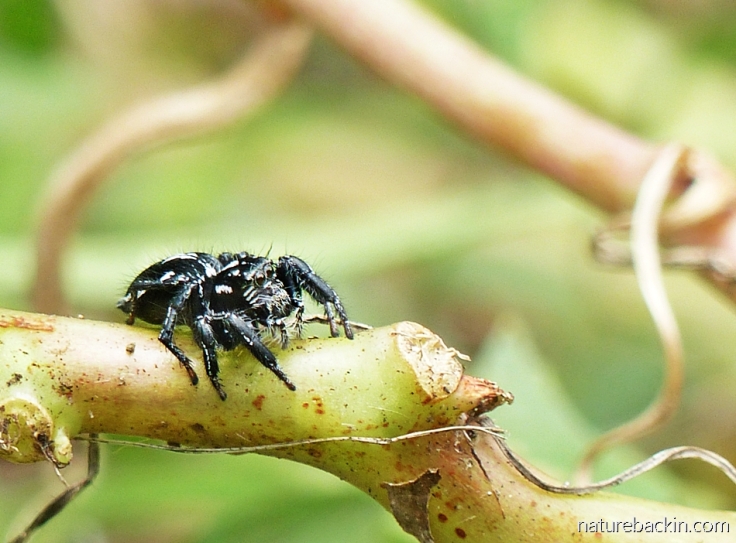
Digressing to a photo of the intriguing little jumping spider
While watching the spider I became aware of a skink, partly concealed by vegetation, on the hunt for prey. I was struck by how almost snakelike it looked and how intense its concentration appeared to be.

The skink lifting its head as it actively seeks out prey
Skinks are lizards, and three suborders – namely, lizards (Lacertilia), snakes (Serpentes) and Worm lizards (Amphisbaenia) – make up the order Squamata, which is a diverse group of reptiles comprising nearly 8000 species.
In southern Africa 338 species (in 48 genera in 9 families) of lizards in the suborder Lacertilia are known to occur. One of these families is the skink family (Scincidae). In southern Africa 10 genera and 74 species of skink are found.
The skinks in our garden belong to the genus Trachylepsis (previously Mabuya). The skink species in this genus are known as typical lizards or typical skinks, and there are 23 Trachylepsis species that occur in southern Africa.

A striped skink scanning for prey in our herb patch
The species in our garden in these photographs is, I think, the striped skink (Trachylepis striata), although it can be difficult to differentiate it from the two other species that occur in urban areas in KwaZulu-Natal, these being the Cape skink (Trachylepis capensis) and the variable skink (Trachylepis varia) (Londt).
Like most skinks, striped skinks are largely terrestrial, although they can climb rough surfaces using their claws. They are active during the hours of daylight.

Wending its way through the nasturtium leaves the skink failed to detect the grasshopper concealed from its view by a leaf above its head. Grasshoppers are on the menu of the insectivorous striped skink
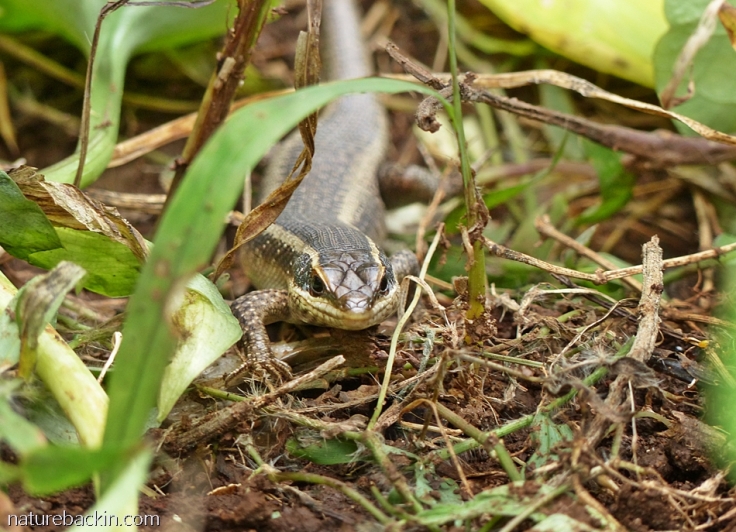
I admit to having felt an irrational twinge of unease when the skink turned and stalked rapidly towards me, unsuccessfully pursuing something unseen by me
Most species of skinks in southern Africa give birth to live young. However, a few species of skinks give birth to live young in some regions in their range, but in other regions they lay eggs. In our region striped skinks give birth to between 3–18 babies in the summer.
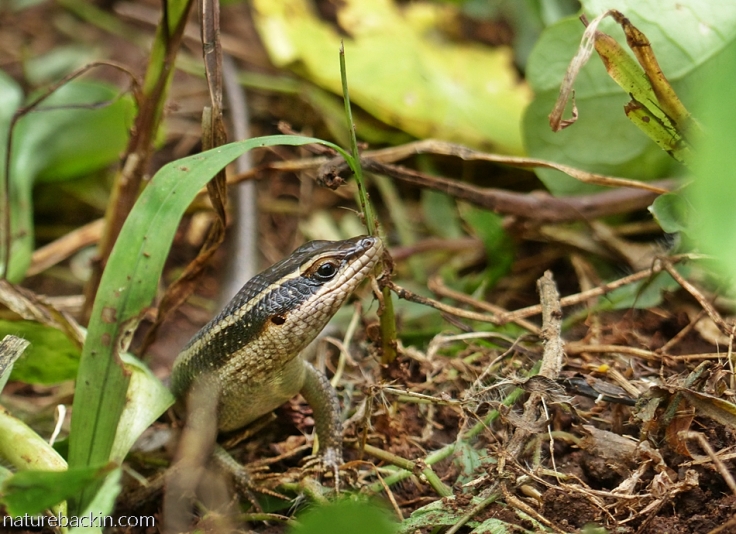
Despite its best efforts the striped skink failed to catch any prey in our herb patch while I was watching

Basking in the sunshine or on a warm rock is where I usually see the skinks in our garden. This adult skink is about 9 cm (3.5 inches) long from the tip of the snout to the base of the tail

I am not sure if this companionable pair of striped skinks is a breeding pair or not

One sunny morning this skink was demonstrating its climbing skills, using its claws to hang on to the rough surface of the wood and bricks. Skinks lack the specialised footpads that enable geckos to cling to even smooth vertical surfaces

This striped skink is showing the transparent lower moveable eyelid that is partially closed. Another genus of skinks, the snake-eyed skinks (Panaspis), have fused eyelids as do snakes, and they look through the transparent lower lid that permanently covers the eye

The same striped skink with the eyelid open

Not exactly a leaping lizard, but I snapped this striped skink scurrying and jumping from log to log on our wood pile, which is a place of shelter and a hunting ground for the skinks
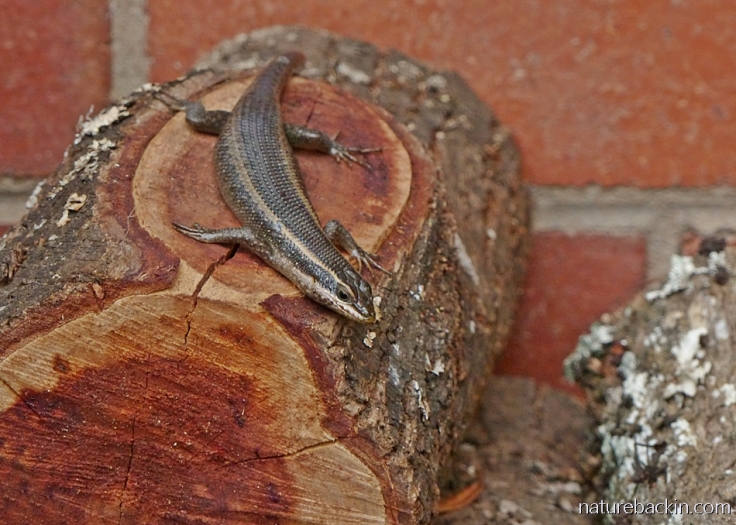
More usually, I see the skinks relaxed and basking in the wood pile
Yesterday afternoon as it was starting to rain I happened to see two juvenile skinks on the garden path. They were probably less than half of the length of the adults and a lot more slender. An adult skink was perhaps coincidentally nearby. From what I can gather, adult striped skinks do not actively parent their young. Because of the rain I had to wait until today to photograph the youngsters.
They only appeared this afternoon. As I sat on the ground with my camera watching one of the youngsters, I was unaware that the second was approaching quite close, and then an adult emerged onto the cement path and lay down calmly watching. All these photos were taken using the zoom lens, but sometimes the skinks approached so nearby to where I was sitting that they were too close to photograph. Unfortunately, I was not able to photograph the adult and youngsters in the same frame.

A young striped skink on the edge of the path. It ignored the ants, even allowing one ant to run along its back
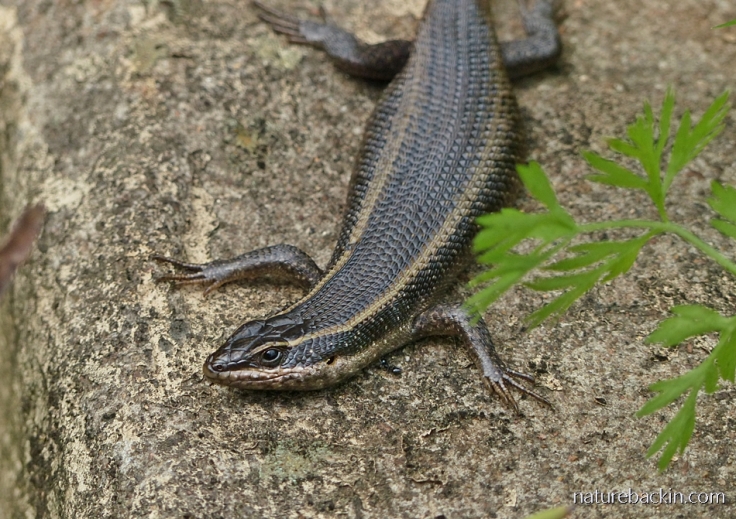
One of the adult striped skinks showing how broad it is relative to the youngsters, and how tiny the ant near its left shoulder looks

Mostly the young skinks basked or foraged on their own, but at one point they did spend a few minutes together on the edge of the path

This adult skink lay on the path nearby watching both me and the youngsters, and probably keeping a lookout for insects too

As luck would have it, distracted by bloodsucking mosquitoes, I looked away from this youngster just as it caught something, so I just got a photo of it chewing and swallowing. At the same time the sun came out from behind a cloud and messed up the exposure. Anyway, I hope the young skink caught a mosquito but it was likely something a bit larger than that
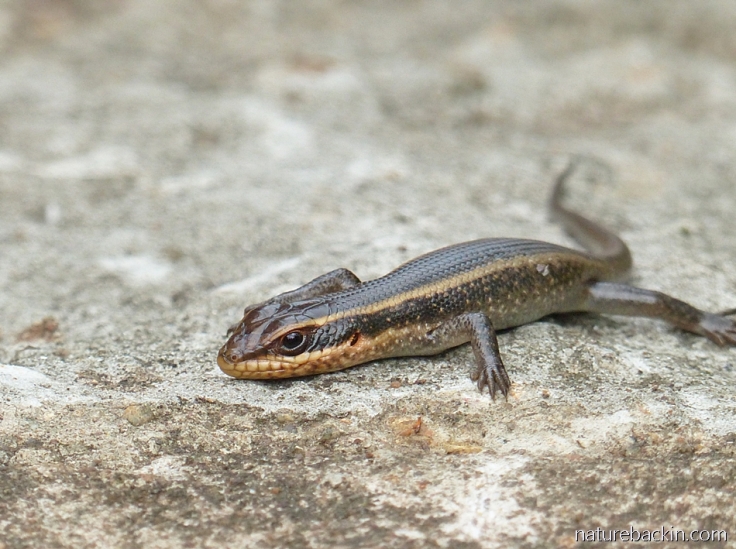
There is not much babyish about the young skinks. At this age they look like little slender adults, although in the photo above, perhaps the youngster’s small forefoot and claws look less well developed than in the adults
Skinks can become relatively tame. Some people even feed them by hand, but as Jason Londt says in his book Suburban Wildlife in KZN , he does not think that people should do this as such familiarity could place skinks in jeopardy. Some people keep skinks captive as pets, but wild animals are best adapted to living their own lives.
Years ago, we had a dog that had an unusually strong prey drive, and yet he tolerated skinks. One afternoon we were all outside on the back deck, and the dog was lying down lizard-like, basking in the sun. A skink came along and rather than go around the prone dog, it decided to climb over the dog and walked the entire length of the dog’s body, disturbing the dog’s short fur with its claws as it walked. Apart from a few twitches of the skin the dog completely ignored it and the skink safely disembarked on the other side.
Usually though domestic cats and dogs hunt skinks. Other predators include snakes and some birds, such as the fiscal shrike. The skinks in these photos steer clear of our cats who only have access to an enclosed garden on the other side of the house.
Like geckos, skinks can shed their tails in response to an attack by a predator, with the possibility that the predator will be distracted by the writhing tail and the reptile can make its escape. The lost tail regenerates, but it requires a healthy and well fed animal for this to happen. When a tail is shed and after the predator has left, a skink will often return to eat the tail and benefit from its nutrients.

An adult skink being very tolerant of me hanging around with the camera
References
Alexander, Graham & Marais, Johan. 2007. A Guide to the Reptiles of Southern Africa. Cape Town: Struik Nature; Londt, Jason. 2009. Suburban Wildlife in KZN. A Wildlife Handbook, WESSA KZN.
Posted by Carol









March 16, 2020 at 1:06 am
Wow, 74 species of skinks in south Africa? I had no idea. They are lovely beings, as is the spider.
LikeLiked by 1 person
March 17, 2020 at 8:18 pm
Yes it is an impressive number!
LikeLiked by 1 person
February 15, 2020 at 2:23 pm
I’ve never heard of a species that gives birth to live young in some parts of its range but lays eggs in other parts of its range.
I appreciate your sharp photographs.
LikeLiked by 1 person
February 16, 2020 at 9:08 pm
Thanks very much. And, yes it is remarkable that some species of skink have different birthing methods.
Btw I came across a discussion of variable reproductive strategies in species of skinks in Australia that is most interesting:
https://www.sciencealert.com/this-lizard-laid-eggs-and-gave-birth-to-live-young-during-the-same-pregnancy
LikeLike
February 17, 2020 at 10:07 pm
You’re right: that’s a good article about a phenomenon most of us have never heard of.
LikeLiked by 1 person
January 29, 2020 at 2:45 pm
They’re all beautiful! Just look at that Skink’s face!! What a cutie
LikeLiked by 1 person
January 29, 2020 at 7:53 pm
They are – definitely beautiful and full of character 🙂
LikeLiked by 1 person
January 17, 2020 at 5:24 pm
My favorite photo is of Grasshopper safely perched on a leaf above unsuspecting, unknowing Skink. And I loved the story of your dog tolerating, even befriending perhaps, the little beasties. My experience of your photography is that it magically shapeshifts you into the species of your subject so that your view is personal and friendly. Just lovely.
LikeLiked by 1 person
January 17, 2020 at 7:01 pm
Thanks for your lovely observations. I like the shape-shifting thought particularly. I did feel quite transported when sitting quietly with the skinks as they allowed me to share a little bit on the edges of their world.
LikeLiked by 1 person
January 16, 2020 at 2:37 am
What amazing photos!And dare I say, skinks are adorable! (And this from more of a bunny loving type.) 🐰
LikeLiked by 1 person
January 16, 2020 at 2:16 pm
I agree, they are surprisingly beguiling, even without being cute and fluffy 🙂
LikeLike
January 15, 2020 at 2:07 am
Another very enjoyable post, Carol, and wonderful to see the Striped Skink featured so beautifully!
LikeLiked by 1 person
January 15, 2020 at 8:17 pm
Thanks – they are more photogenic than one might expect.
LikeLiked by 1 person
January 13, 2020 at 12:48 pm
Hello Carol,
Such beautiful photos of a fascinating lizard! I can almost feel their personality through each shot. I enjoyed learning about these wonderful creatures. Thank you for sharing 🙂
Best wishes,
Takami
LikeLiked by 1 person
January 13, 2020 at 7:11 pm
Thanks Takami – yes, while watching them I also felt they have real personalities 🙂
LikeLiked by 1 person
January 12, 2020 at 9:45 am
Another fascinating account, Carol, thank you as always 🙂 Some extraordinary photos here; I love the skink and the grasshopper!
LikeLiked by 1 person
January 13, 2020 at 6:50 pm
The skink and the grasshopper in one frame was so lucky 🙂 Thank you Sandra.
LikeLiked by 1 person
January 12, 2020 at 6:18 am
One of my favourite creatures around the garden, and sometimes venturing into our house. Beautiful blog and photos, thank you Carol! xxx
LikeLiked by 1 person
January 13, 2020 at 6:46 pm
Glad to know that you also enjoy having skinks around. Thanks Christeen.
LikeLiked by 1 person
January 11, 2020 at 8:11 pm
These are remarkable photos. How do you do it? And that dog of yours was pretty remarkable too. I echo Nikki Brighton’s comments too.
LikeLiked by 1 person
January 13, 2020 at 6:46 pm
Thank you very much Margaret – and yes he was a remarkable dog, an extremist, but he did moderate with age.
LikeLiked by 1 person
January 13, 2020 at 8:14 pm
Don’t we all?
LikeLiked by 1 person
January 13, 2020 at 8:29 pm
Erm – not always!
LikeLiked by 1 person
January 10, 2020 at 11:22 am
Awesome photographs, Carol and such an interesting read.
LikeLiked by 1 person
January 10, 2020 at 12:08 pm
Thanks so much Kamal. Such lovely little creatures that are so trusting are indeed a blessing 🙂
LikeLike
January 10, 2020 at 4:42 pm
Yes absolutely true and they sure r so guileless. Welcome 😊😊😊😊
LikeLiked by 1 person
January 13, 2020 at 6:40 pm
Guileless is a really apt description. Thanks again Kamal.
LikeLike
January 13, 2020 at 6:41 pm
Welcome 😊😊😊😊
LikeLiked by 1 person
January 10, 2020 at 10:09 am
I love your gorgeous photographs. Thank you, Carol.
LikeLiked by 1 person
January 10, 2020 at 12:07 pm
Great to hear that, thanks very much Isabel.
LikeLike
January 10, 2020 at 7:42 am
Again, I have learnt new things and from now on will look more closely and with more interest at the lizards in our garden. I agree that they are almost snakelike, especially when seen so “close and persona” through your magical camera lens.
Did you finish weeding the herb garden, I wonder! (I weeded ours this very week, and composted it, just before these days of the most wonderful, soft, oh so welcome, rain)
LikeLiked by 1 person
January 10, 2020 at 12:06 pm
In my book on reptiles, it is said that the distinction between lizards and snakes is an artificial convention, and taxonomically snakes are a type of lizard. I am sure that you will enjoy looking more closely at the lizards in your garden. The wonderful detail of their scaled skin is remarkable and their rapid transformation from lounging lizard to lightning-fast predator is incredible too.
Weeding our so-called herb patch, which is really a wild and unruly spot with an occasional herb, is ongoing and piecemeal 🙂 What great timing that you got weeding and composting done ahead of the unexpected good rain. Great that it was soft and gentle and generous without any drama such as floods and washaways. I hope your region gets a lot more of the same in the weeks ahead.
LikeLiked by 1 person
January 10, 2020 at 4:52 am
Such a wonderful record of small treasures. I would imagine that many people overlook the little things around them, but you delight me always with your attention to detail and meticulous research. Add in glorious images, and I am hooked!
LikeLiked by 2 people
January 10, 2020 at 11:58 am
Thanks for your very kind comment Nikki 🙂 I agree that these creatures are small treasures, and they are most rewarding to watch and well worth paying attention to.
LikeLike
January 10, 2020 at 4:45 am
What a fun set of photos. I particularly like the one with the grasshopper, showing the fine margins between success and failure. I’ve always liked reptiles, and the geckos, anoles and skinks here are entertaining and educational to watch. While the geckos and anoles will hang around, mostly the skinks disappear very quickly so I don’t see them as much.
LikeLiked by 1 person
January 10, 2020 at 11:54 am
Your observation that the margins between success and failure are fine is so true. In this case the leaf provided success for the grasshopper and failure for the skink!
It seems you have a rich diversity of reptiles in Hawaii. Anoles do not occur on the African continent. They look to be most intriguing too. Strange how the skinks here can be very confiding, but not so where you are.
LikeLiked by 1 person
January 11, 2020 at 6:01 am
I suspect the skinks here are made skittish by the gold dust day geckos, which are very cute but can be quite aggressive in going after other geckos and other creatures such as skinks.
LikeLiked by 1 person
January 13, 2020 at 6:41 pm
I suppose that shows that cuteness is in the eye of the beholder!
LikeLiked by 1 person
January 10, 2020 at 4:31 am
I admire your patience as always – it has been amply rewarded and we benefit from it. This summer (is it the drought?) our garden is filled with skinks and geckoes on rocks, logs, and the outside walls – as well as indoors. I love watching their antics.
LikeLiked by 2 people
January 10, 2020 at 11:48 am
Thanks Anne, and as I have mentioned before, it never feels like I am being patient as it becomes totally engrossing to watch little animals that I usually look at only fleetingly. Lovely that you also enjoy watching skinks and geckoes, and interesting that they are prolific in your space this season. They must also be appreciating your recent and long overdue rain!
LikeLike
January 9, 2020 at 9:11 pm
Even though I’m not a big fan of reptiles, these photos show the charming side of skinks. Nicely done!
LikeLiked by 1 person
January 10, 2020 at 11:42 am
Thanks Eliza, and even though you are generally not that keen on reptiles its great that you remain open-minded enough to appreciate the charm of these little skinks. I am delighted to have served as a skink ambassador 🙂
LikeLike
January 10, 2020 at 1:52 pm
🙂
LikeLike
January 9, 2020 at 8:56 pm
It’s taken me awhile to get more comfortable with our resident skinks and lizards. We have a beautiful blue-tailed skink. (https://petponder.com/interesting-facts-about-blue-tailed-skink-lizard). Eric has managed to get pictures of it, but I haven’t caught one. They seem a bit more shy than our other, less colorful models. While looking for a pic to show you, I encountered the fact that our blue-tails can voluntarily drop their tails as a defensive mechanism. Then regrow it. We had one (not the blue-tailed variety) we called “Stumpy” because it was in the process of regrowing a tail.
Fascinating how you manage to insert your camera and your personal focus on every living thing. It’s always fun to learn from your posts. If I haven’t already, wishing you a very happy 2020.
LikeLiked by 1 person
January 10, 2020 at 11:37 am
Thanks Gunta and for your good wishes. Your blue-tailed skinks are very beautiful. I gather that in SA many lizards can shed and then regenerate their tails, but some such as agamas, chameleons and monitors, can’t.
In this blog I try to narrate my personal encounters and discoveries in nature to make it more relatable (even though I am not really a fan of the word relatable :))
Best wishes to you to for a happy 2020 filled with great new experiences and wonder.
LikeLike
January 9, 2020 at 8:44 pm
Loved your tale of the skinks on the hunt, Carol. Fantastic close-ups of this interesting creature along with interesting facts. Thanks!
LikeLiked by 2 people
January 10, 2020 at 11:27 am
Thank you very much Jane. They are interesting and engaging little creatures, and reasonably cooperative in front of the camera too 🙂
LikeLiked by 1 person